
The wrasses are a family, Labridae, of marine fish, many of which are brightly colored. The family is large and diverse, with over 600 species in 81 genera, which are divided into 9 subgroups or tribes. They are typically small, most of them less than 20 cm (7.9 in) long, although the largest, the humphead wrasse, can measure up to 2.5 m (8.2 ft). They are efficient carnivores, feeding on a wide range of small invertebrates. Many smaller wrasses follow the feeding trails of larger fish, picking up invertebrates disturbed by their passing. Juveniles of some representatives of the genera Bodianus, Epibulus, Cirrhilabrus, Oxycheilinus, and Paracheilinus hide among the tentacles of the free-living mushroom corals & Heliofungia actiniformis.

The slippery dick is a species of wrasse native to shallow, tropical waters of the western Atlantic Ocean.

The ocellated wrasse is a species of wrasse native to the eastern Atlantic Ocean and throughout the Mediterranean Sea, the Black Sea, and the Sea of Azov. It inhabits areas with rocks and eelgrass at depths from 1 to 30 m. It feeds on various marine invertebrates. This species can reach 12 cm (4.7 in) in standard length. It can also be found in the aquarium trade.

The corkwing wrasse is a species of wrasse native to the eastern Atlantic Ocean from Norway to Morocco and out to the Azores, as well as being found in the Mediterranean Sea and the Adriatic Sea. This species can be found in areas of rock or eelgrass at depths from 1 to 30 m.

The Mediterranean rainbow wrasse is a small, colourful fish in the family Labridae. It can be found in the Mediterranean Sea and in the northeast Atlantic Ocean from Sweden to Senegal. Records of this species south from Senegal and the Cape Verde Islands are actually the closely related Coris atlantica.

The queen coris, also known as the sand wrasse, Queen coris wrasse, Formosan coris, Formosa coris wrasse, Formosa wrasse, Indian Ocean wrasse or Indian sand wrasse, is a species of wrasse native to the Indian Ocean from the Red Sea and the coast of Africa to Sri Lanka. This species appears in the aquarium trade due to its vibrant colors. A special feature about this species is how much they change from juvenile to adult form, in color, behaviour, and diet.

Symphodus is a genus of wrasses native to the eastern Atlantic Ocean and the Mediterranean Sea.
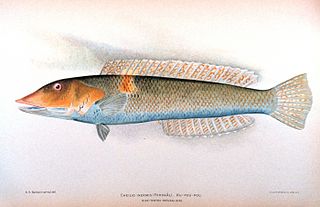
The cigar wrasse, Cheilio inermis, is a species of wrasse native to the Indo-Pacific. It is mainly found on tropical reefs at depths to 30 m (98 ft) in the Indo-Pacific region, Red Sea included. They inhabit seagrass beds and algae-covered flats, occasionally in lagoon and seaward reefs to a depth of at least 30 m. They are a mostly solitary species. Their diet includes crustaceans, mollusks, sea urchins, and other hard-shelled prey.

The brown wrasse is a species of wrasse native to the Eastern Atlantic from Portugal to Morocco, including the Azores, as well as in the Mediterranean Sea. This species can reach 45 cm (18 in) in standard length, though most do not exceed more than 40 cm (16 in).
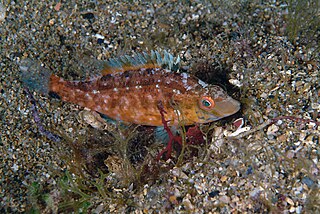
The grey wrasse is a species of wrasse native to the eastern Atlantic Ocean and along the coasts of the Mediterranean Sea to the Black Sea. It inhabits coastal waters, preferring beds of eelgrass at depths from 1 to 20 m. It can reach 16 cm (6.3 in) in total length, though most do not exceed 8 cm (3.1 in). It is important to local peoples as a food fish and is popular as a game fish. It can also be found in the aquarium trade.
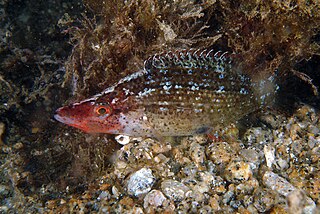
The pointed-snout wrasse, also known as the long-snout wrasse, is a species of marine ray-finned fish, a wrasse from the family Labridae which is native to coastal waters of the Mediterranean Sea and the Black Sea. This species can also be found in the aquarium trade and is occasionally taken in artisanal fisheries.

The East Atlantic peacock wrasse is a species of wrasse native to the eastern Atlantic Ocean from Spain to Morocco and in the coastal waters of the Mediterranean Sea and the Black Sea. This species lives around rocks surrounded by eelgrass and can also be found in brackish waters in lagoons. It occurs at depths from 1 to 50 m. This species can reach 44 cm (17 in) in standard length, though most grow no larger than 25 cm (9.8 in). This species is sought as a game fish and is also important to local peoples as a food fish. It can also be found in the aquarium trade.

The axillary wrasse is a species of wrasse native to the eastern Atlantic Ocean from the Azores and Madeira to the coasts of Portugal to Morocco and then along the coastal waters of the Mediterranean Sea. This species can be found in eelgrass beds at depths from 1 to 50 m. It can reach 18 cm (7.1 in) in standard length, though most do not exceed 12 cm (4.7 in). This species is important to local peoples as a food fish and is also sought as a game fish. It can also be found in the aquarium trade.
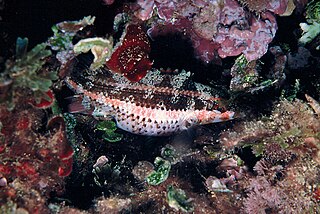
Symphodus doderleini is a species of wrasse native to the coasts of the Mediterranean Sea through the Sea of Marmara. It can be found in beds of eelgrass at depths of from 2 to 40 m, and can reach 10 cm (3.9 in) in standard length.
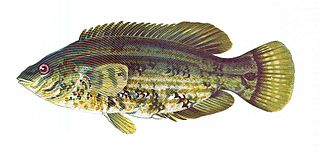
Baillon's wrasse is a species of wrasse native to the eastern Atlantic Ocean from the British Isles and Belgium to Mauritania and the western Mediterranean Sea along the coast of Spain and around the Balearic Islands. This species inhabits areas with plentiful weed growth or around rocks at depths from 1 to 50 m. It can reach 23 cm (9.1 in) in standard length, though usually not exceeding 18 cm (7.1 in). The British Record for the heaviest fish is 285 grams caught in Poole Bay, Dorset on 3 September 2018 by David Lynes It is caught for human consumption in artisanal fisheries.

The spotted wrasse, Anampses meleagrides, is a species of wrasse native to the Indian Ocean from the Red Sea and East Africa to the western Pacific Ocean to Samoa and the Tuamoto Islands and north to Japan. This species is found on coral reefs at depths of 3 to 60 m. It can reach a length of 22 cm (8.7 in). It is of minor importance to local commercial fisheries and can be found in the aquarium trade.

The nebulous wrasse is a species of wrasse native to the Indian Ocean and the western Pacific Ocean. It can be found in groups at depths from 1 to 40 m on reef flats. This species feeds on fish eggs and benthic invertebrates, including crabs, sea urchins, ophiuroids, polychaetes, sponges and mollusks. Its coloration varies, ranging from brown to dark green. This species can reach 12 cm (4.7 in) in total length. It can be found in the aquarium trade.
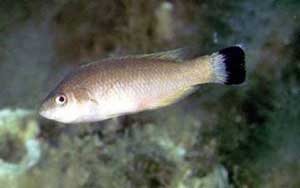
Centrolabrus melanocercus, the black-tailed wrasse, is a species of marine ray-finned fish from the wrasse family Labridae which is found in the Mediterranean Sea and the Sea of Marmara. This species was formally described in 1810 as Lutjanus melanocercus by Antoine Risso with the type locality given as Saint Hospice near Villefranche-sur-Mer on the Mediterranean coast of France. This species was regarded as a member of the genus Symphodus but meristic and behavioural data placed it closer to the rock cook than the sexually dimorphic paternal nesting fishes in Symphodus. This species prefers areas with rocks or eelgrass at depths from 1 to 25 m. It can reach 14 cm (5.5 in) in total length, though most do not exceed 11 cm (4.3 in).
Symphodus caeruleus is a species of marine ray-finned fish, a wrasse from the family Labridae. It is endemic to the Azores in the eastern Atlantic Ocean.
The emerald wrasse is a species of marine ray-finned fish, a wrasse from the family Labridae. It is endemic to the eastern Atlantic Ocean where it is found in the Macaronesian archipelagoes of the Canary Islands and Madeira, including the Savage Islands. This species was formerly thought to be found in the Azores but the specimens there were found to belong to a separate species Symphodus caeruleus.



















